The post A Gaucho’s Life in San Antonio de Areco appeared first on The Expeditioner Travel Site.
]]>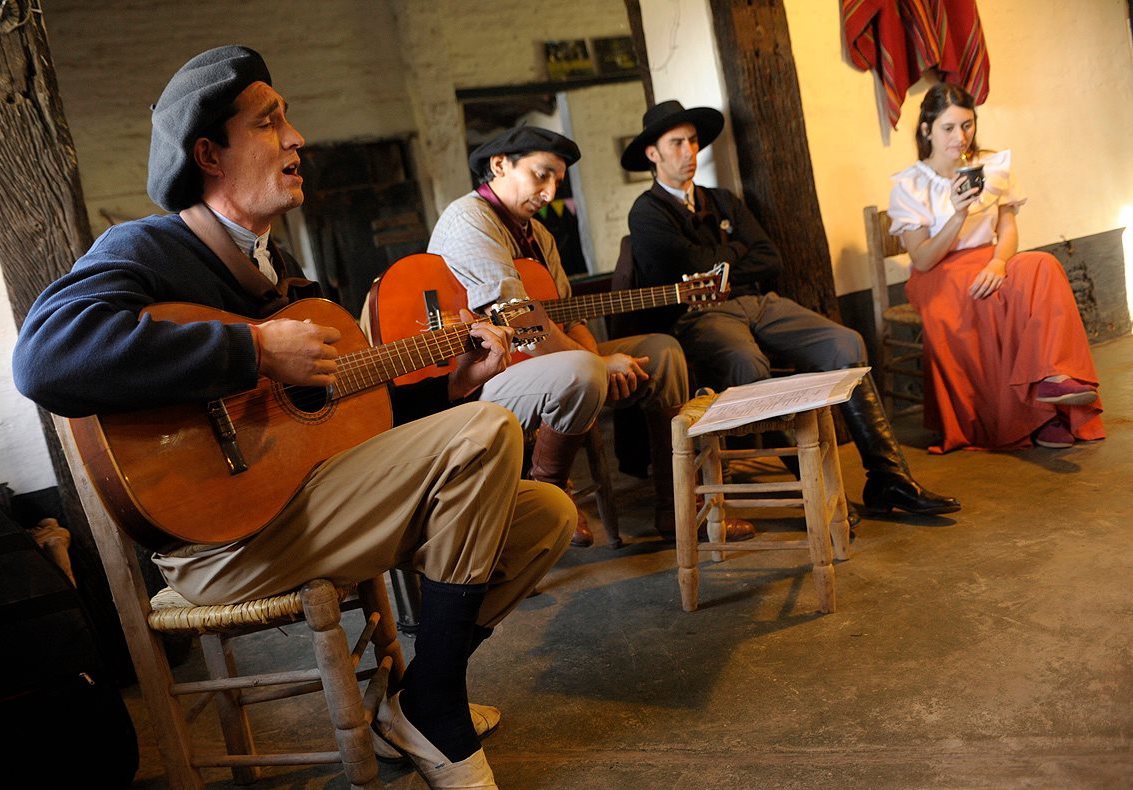
When thinking about Argentina, what comes to mind? Americans will say meat, Europeans will think about football/soccer, and South Americans will mention tango — but locals will talk about the mythical gauchos.
In the middle of the Argentinian Pampas, only a 60 miles from Buenos Aires, stands a little town, to all appearances very quiet, but keen to preserve the country’s habits and customs. San Antonio de Areco was founded in 1730, and it is today probably the town that best symbolizes gauchos’ traditions of the past. For 80 years now, this town has held the Festival of Tradition every November, which is considered to be the oldest celebration in Argentina.
An Origin Dating Back to the 30’s
The origin of the festival is linked to the history of San Antonio de Areco. Located at the edge of the town, along the Camino Real, the Ricardo Güiraldes Museum is one of the unmissable places of interest in Areco. Its name pays tribute to the famous Argentinian writer, poet and novelist Ricardo Güiraldes, whose family owned estancias in San Antonio de Areco.
His popular novel, Don Segundo Sombra, drew inspiration from the way of life of a gaucho arequero (Areco’s dwellers), and was so successful that the mayor of the town at that time decided to establish the Tradition Day in San Antonio de Areco in 1939. This celebration originally took place in Areco and Lujan, a town only a stone’s throw away from Buenos Aires. It was only in 1984 that an ordinance law was adopted and ordered that San Antonio de Areco become permanent headquarters of the Tradition Day.
The first celebration was organized in the main streets of the town in 1939. Only a few horse shows, such as rodeos, were planned. At night, a barbecue (asado in Spanish) was made and traditional dances and authentic folkloric music were performed.
The Festival of Tradition today
Today, the Festival of Tradition is much more than a simple day celebrating traditions of a period kept in old ages. This unique cultural event gathers thousands of gauchos from all over the country, and of all ages and origin. It always takes place the week of November 10 to celebrate the birthday of José Hernandez, Argentinian poet and journalist, especially famous thanks to the poem Martin Fierro, which, just as Don Segundo Sombra, refers to the gauchos’ life in the campo. This date was chosen in order to pay tribute to this literary icon, who devoted his life to defend the gaucho’s identity and his role in the independence of Argentina.
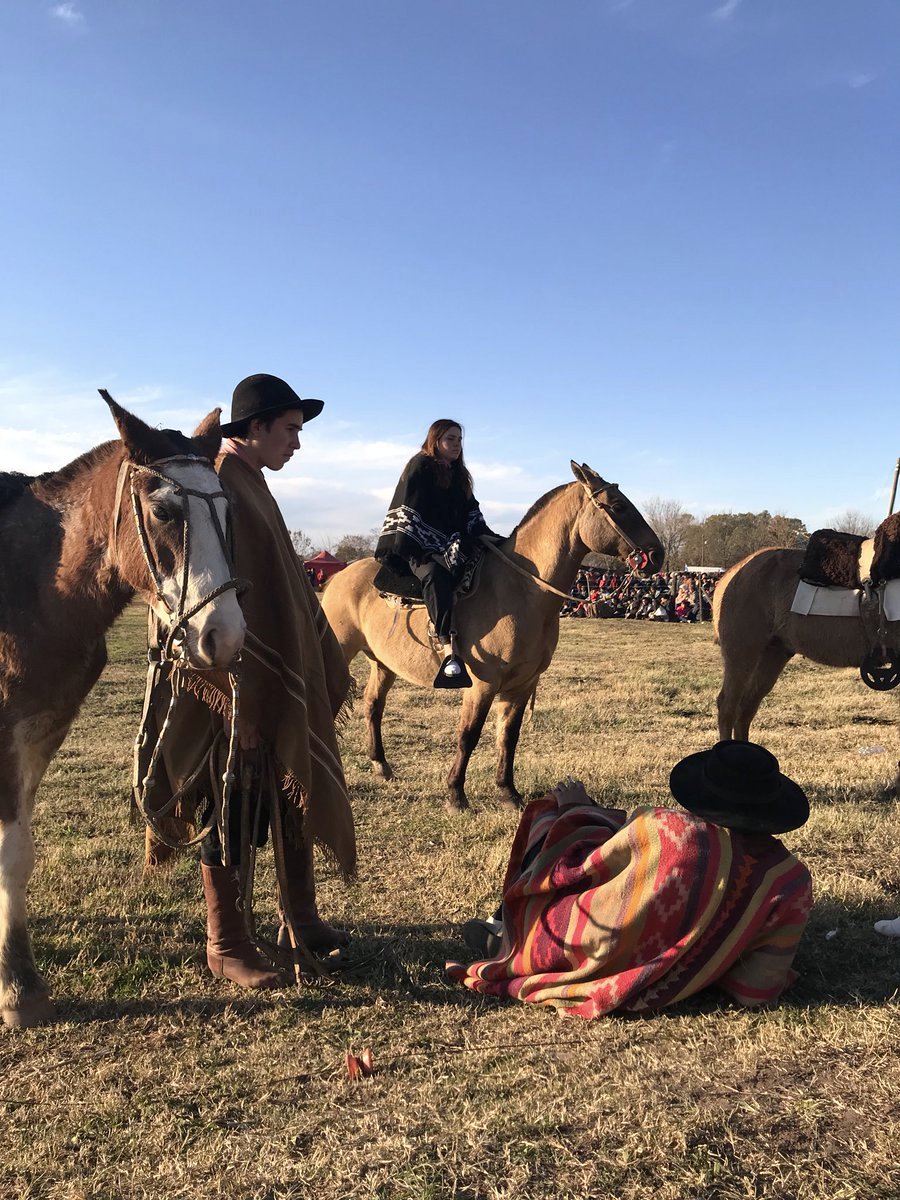
All along the week, interesting exhibitions, captivating concerts and elegant dances are performed at the four sides of the town. During the weekends, horse-riding competitions, horseback games and jineteadas are carried out. Jineteadas refers to rodeos, in the style of South America. The gaucho attempts to stay on a young, wild horse from 6 to 15 seconds. This event is one of the most attended in the festival as it provides gauchos with the opportunity to challenge one another and to prove their strength, dexterity and bravery.
The show’s climax is the parade of gauchos throughout the town. Horsemen and horses get together under the crowd’s applause and march in the cobbled streets of San Antonio de Areco. Today, according to the tradition, the Argentinian flag should be held by Oscar Peyrena, one of the most emblematic gauchos of the province.
The festivities don’t stop when night falls. In the streets, a delicious smell of grilled meat permeates, couples chat and get drinks while rhythmic guitarreadas(folkloric music) play all day and curious travelers listen to the stories told by locals sitting around a bonfire.
Have a walk in the streets of Areco during the Festival of Tradition, and you will be carried away by this surprising festival. Only an hour away from the crush of the capital city, San Antonio de Areco is a journey back in the past and is a good example of the country’s cultural diversity. Peasants, craftsmen, dancers, musicians, artists and gauchos try hard to revive the old local habits, so as to preserve this unique heritage among a population, eager to protect all the legends of Argentina.

/
 The travel agency Areco Tradicion was created with the idea of introducing a traditional town strongly marked by the gauchos’ footprint: San Antonio de Areco. It was founded in 2013 by Bertrand Mahé, a professional photographer and lover of the large wild Argentinian landscapes and Andrés Ferrante, founder of the Portal Areco, a tourism website about San Antonio de Areco and its surrounding regions. In 2015, Sarah Reynier decided to leave Buenos Aires, where she had been living for two years, and join the team of Areco Tradición in San Antonio de Areco. To learn more about the Festival of Tradition, visit Arecotradicion.com/en/homepage/.
The travel agency Areco Tradicion was created with the idea of introducing a traditional town strongly marked by the gauchos’ footprint: San Antonio de Areco. It was founded in 2013 by Bertrand Mahé, a professional photographer and lover of the large wild Argentinian landscapes and Andrés Ferrante, founder of the Portal Areco, a tourism website about San Antonio de Areco and its surrounding regions. In 2015, Sarah Reynier decided to leave Buenos Aires, where she had been living for two years, and join the team of Areco Tradición in San Antonio de Areco. To learn more about the Festival of Tradition, visit Arecotradicion.com/en/homepage/.
The post A Gaucho’s Life in San Antonio de Areco appeared first on The Expeditioner Travel Site.
]]>The post The Narrows appeared first on The Expeditioner Travel Site.
]]>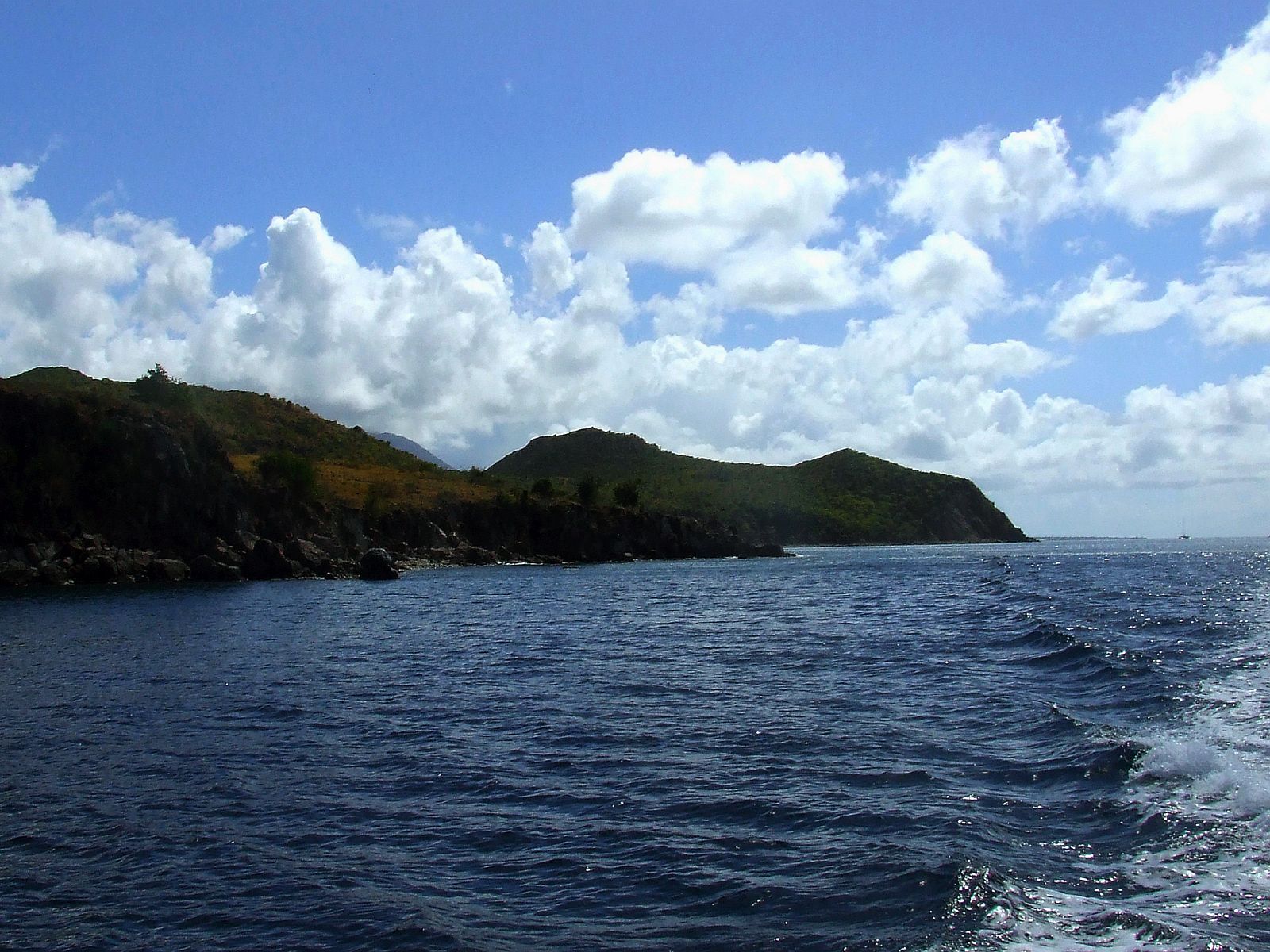
A dark shape glided by beneath me, a manta ray, its great wings undulating. It moved with such grace, at such a leisurely pace, I had half a mind to slow down and linger. Meanwhile, on the surface, I thrashed away in the throes of competition — a 55-year-old man somewhere between Nevis and St. Kitts — on the verge of oxygen debt.
It had started innocently enough, the idea to compete in a 2.5-mile, open water swim race while vacationing with my girlfriend in the West Indies. I gave myself six months to prepare, joined a Masters swim group, woke at five most mornings to work out and averaged twelve miles a week.
I spent my free time watching swimming videos and fell asleep at night reading articles on stroke mechanics. I wasn’t coming to this new, I should point out. I had been a serious swimmer in my thirties (nationally ranked at two miles) but hadn’t trained in close to 20 years. Why, after all this time, the sudden desire to race? Well, along with my recent career change and divorce, chalk it up to a midlife crisis.
A month before the race I came down with the flu, which a week later turned into pneumonia. Then, just as I was beginning to feel normal again, I succumbed to food poisoning. All told, I missed three weeks of training and was left with only a week to prepare before the race.
My girlfriend, Cathy, and I departed as planned. My hope was that I might still have some residual fitness left. As our little prop-plane made its approach to Nevis, I looked down upon the rolling whitecaps of the channel between Nevis and St. Kitts — the very water I would cross in a few days — and felt my stomach churn with anxiety.
We stayed at the Montpelier Plantation on Nevis, a 300-year-old sugar plantation converted into a resort, situated high up on the crest of a hill with views of the Caribbean on one side and the island’s towering volcano on the other. The resort positively thronged with vegetation: vast groves of palm trees, pathways arced by giant ferns, luxuriantly petaled flowers. We fell asleep to the braying of donkeys, woke to the chatter of monkeys and the cries of exotic birds.
Secluded and colonial-chic, the resort felt like a British rock star’s retreat, with independent cottages, two gourmet restaurants, yoga classes, a 20-meter lap pool and a private beach. At night, an eccentric mix gathered by the bar: a hedge fund retiree with his much younger wife; a vaguely famous New York actor and his family (“Wasn’t he in the movie Chef?”); a pair from England itching to swap partners and a silver-haired couple from Hyannisport, draped in cashmere and Kennedy ideals.

The event, the annual Bente Weber Memorial Cross Channel Swim, has become one of the premier open water races on the planet (part of the Global Swim Series), attracting elite swimmers from around the world. It started in 2002 as a way of remembering a local swimmer who died of cancer. In more recent years, however, it has morphed into a means of raising awareness for the plight of the local sea turtle population.
230 swimmers signed up, including three former Olympians: American Ashley Whitney, gold medalist in Atlanta (4×200 freestyle relay); Britons Keri-Anne Payne, silver medalist in Beijing (10km); and Greg Whyte. Needless to say, this meant that the first three spots were spoken for. My irrational goal was to finish in the top ten.
Between the two islands, the Caribbean (to the west) and the Atlantic (to the east) meet like two vying forces, guaranteed to create rough water. When she heard I was doing the race, the resort’s owner smiled and said, “Well, let’s hope it’s not like last year. We wouldn’t want you to end up in Nicaragua.” Apparently, a number of swimmers dropped out in 2016, floundering in the giant swells, pushed woefully off course.
The morning of the race, a mob of swimmers and spectators descended upon Oualie Beach, a frenetic buzz in the air. I spotted Greg Whyte being interviewed by a local TV news reporter, the camera trained on his physique. I had never seen a body so defined, every muscle worked within an inch of its life. To say I felt intimidated would be an understatement. When he turned, I saw the five Olympic rings tattooed on his back.
My ever-thoughtful and practical girlfriend lathered my back with sunblock. “Do you know where you’re going?” she asked.
I smiled and motioned vaguely to the north, toward three jagged peaks, the only visible landmarks on St. Kitts. “Don’t worry,” I said, “I’ll just follow the lead swimmers.”
She looked dubious. “Didn’t you hear the instructions?”
“They said something about navigating by one of the peaks.”
“Which one?”
I shrugged (a moment that would come to haunt me). “I’m sure there’ll be boats or buoys out there . . .”
The field lined up on the immaculate white sand. The water looked calm, waves no higher than our knees. I adjusted my goggles, reminded myself to go out slower than I wanted. The countdown resounded over the bullhorn, and then, before I could assimilate what I was about to do, the pistol fired.
I ran, legs splayed, into the surf, and knifed through the cerulean depth, jockeying to find clear water and the truest line. Concentrating on my form, I embarked, exerting all my effort to be effortless. Every half-dozen strokes or so, I lifted my head to sight. Very soon, I found myself separated from the field, the utter vastness of the sea upon me, while, to the east, I could see where the lead swimmers surged ahead, forming a splashing furrow of white.
I knew I was missing an opportunity: by drafting off the heels of another swimmer I could save up to 25% of my energy. But I stayed to my line, relishing being out of the fray, keeping to my own rhythm. The water was smooth, just a slight westward swell. Not wanting to lose contact with the leaders, I put my head down and picked up the pace. The visibility was startling: 50 feet down I could see bright orange starfish scattered across the sea floor and, now and then, a turtle or manta ray or school of technicolor fish.
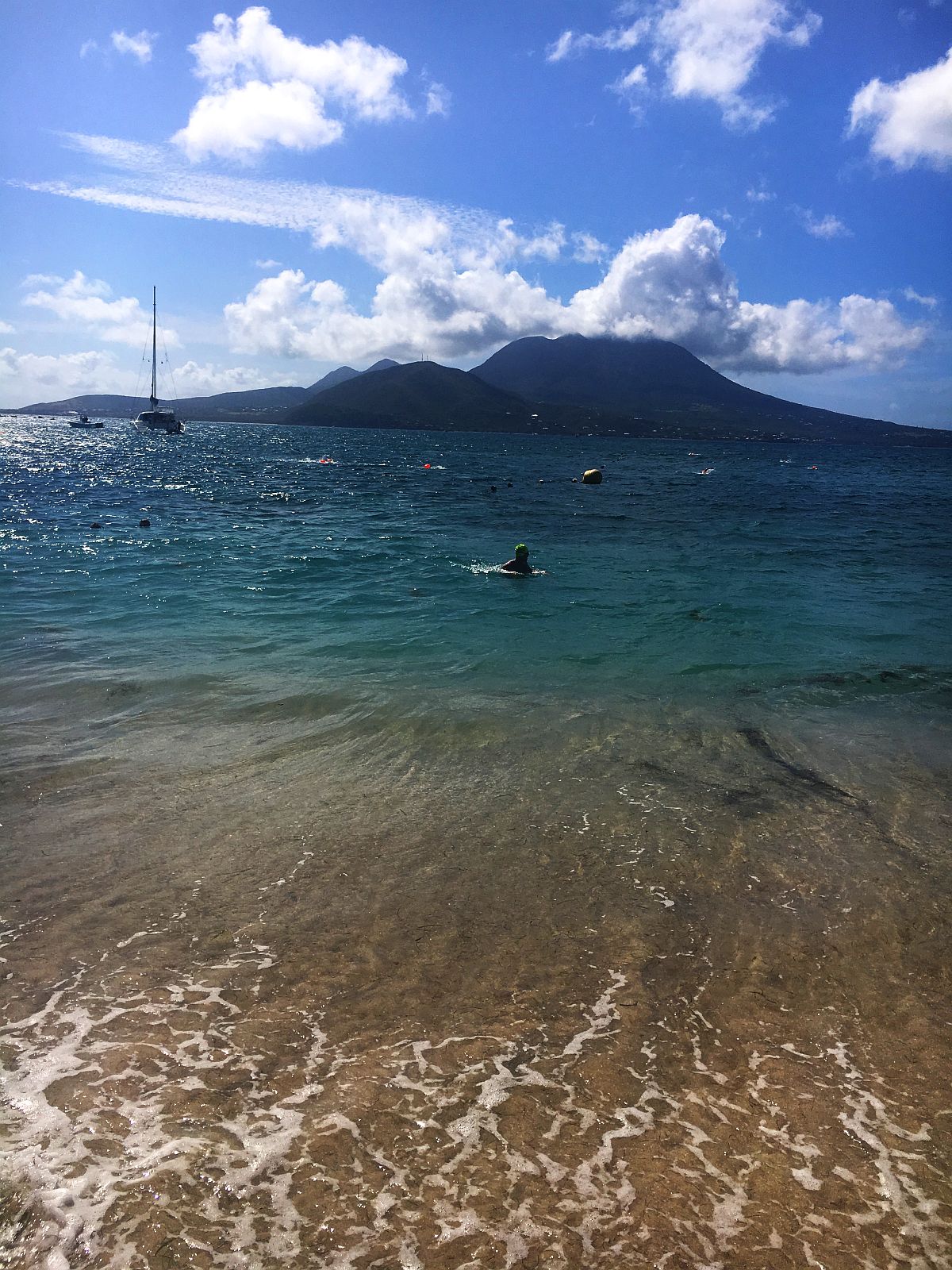
As I neared the center of the channel, known as “the Narrows,” the water turned rough — big cresting waves rolling east to west — throwing off my stroke. For moments, I found myself hanging in midair with nothing to sink my hands into before plunging down the face of the wave. Demoralized, I plowed on, certain my race had gone off the rails. Then, just as I got used to the swells, they abruptly changed, coming at me from all directions.
I lifted my head and saw what looked like a reef or rock wall blocking my way. No one mentioned this before the race! The surf crashed against the rocks, then swept back, leaving me suspended, as if in a washing machine. I spotted another swimmer in front of me who had found himself at the same impasse. Which way? I thought. Just then, east of the rocks, two West Indians in a small motorboat cried out something unintelligible, motioning with their arms to go the other way. My competitor and I dug in, surging around the wall. After five hard minutes, I pushed past him and kept up the momentum. When I finally rolled onto my back to see where he was, he was nowhere to be found.
But then, as I looked around, I realized there was nothing in sight, not a boat or buoy or another living soul. Wherever I turned, I saw nothing but an endless expanse of heaving sea, and it all looked the same. The water was deep here, petrol blue beneath my feet, and I felt like some small, defenseless prey. The waves lashed, buffeted against me, lifting then dropping me a full story. For some moments, I had no idea where to go and began to panic. Where were the other swimmers? Had the current pushed me so far off course? And where in God’s name was the shoreline?
And then it hit me: I was alone — utterly and horrifyingly alone.
As each wave launched me into the air, I spun around, frantically looking for land. I saw nothing but palettes of blue and light dancing everywhere. At last, the three peaks appeared, but now, from this vantage point, they were not grouped close together but far apart. Maybe half a mile separated each peak. So, which was the finish line? I thought back to the pre-race meeting and cursed myself for not listening. Spontaneously, like a good former Buddhist, I chose the middle way.
I set out at a frenetic pace, trying to salvage what remained of my race. As my form deteriorated, I found myself throwing my arms at the water. Then, to make matters worse, I sensed a new current coursing down the coast of St. Kitts, coming straight at me. I was still a good half-mile from shore when, out of the depths, the sea floor rose up like a revelation. The water felt velvety and thick, and it seemed the same starfish lingered beneath me stroke after stroke.
Still uncertain if I was even on course, I kept lifting my face to scan the horizon. But what should I find beyond an olive-colored backdrop? The water grew shallower by the minute. A continuous flow of sea life passed beneath me: more turtles, a barracuda, a wall of neon yellow angelfish. And then, as I raised my head, I spotted an arch, a brilliant white arch, strewn with flags, rising above the beach—the finish line. By dumb luck, I had found it.
Such a short distance remained, maybe two or three football fields, but it seemed to take forever to cross, like swimming upstream. The moment my hand touched sand, I climbed to my feet, collapsed, got up again, and bounded through the archway looking, as Cathy later put it, “like a lumbering ape.”
“Where did I finish?” I asked, the first thing out of my mouth as Cathy hugged me.
“Thirteenth,” she said. The winner had finished twelve minutes ahead of me and set a new course record (55:28). As expected, the first three spots went to the Olympians: Ashley Whitney (1st), Greg Whyte (2nd) and Keri-Anne Payne (3rd). I felt exhausted but elated, and recognized, for the first time that day, that my back was scorched from the sun. I might have missed the top ten, but I was just grateful to have made it as I thought back to the Narrows and my sense of being lost out there. All at once, I felt suffused with the kind of satisfaction that comes after conquering what you fear. And I wanted to do it again.
After collecting my age group award (a nine-inch sculpture of a sea turtle), I joined Cathy at the crowded Reggae Beach Bar on Cockleshell Beach, where she sat next to a tall, exceedingly fit young woman in a bathing suit with shoulder-length black hair.
“But you look so relaxed . . .” Cathy said to the woman. “You don’t look like someone who just swam a race.”
The woman smiled and shrugged. “I swim a lot.”
Cathy turned to me. “Jay, this is Keri-Anne from England.”
We said hello and shook hands, when it dawned on me: this was Keri-Anne Payne, two-time World Champion, Olympic silver medalist, one of the greatest marathon swimmers on the planet. As I struggled, dumbstruck, to formulate a sentence, she stood and said, “Well, I should be going . . .”
“Where?” We asked.
“Nevis,” she said. She was heading back to escort the Special Olympics’ swimmers across. Then she put on her swim cap and goggles and started for the sea.

 Jay Hoy Kauffmann teaches Literature and Creative Writing at the Miller School of Albemarle and Writer House in Charlottesville, Virginia. Winner of the Andrew Grossbardt Memorial Prize and nominee for a Pushcart Prize, his fiction, essays and travel pieces have appeared in Lumina, Upstreet, CutBank, Gulf Stream, Prime Number, Storyglossia, Mid-American Review and many other journals and anthologies.
Jay Hoy Kauffmann teaches Literature and Creative Writing at the Miller School of Albemarle and Writer House in Charlottesville, Virginia. Winner of the Andrew Grossbardt Memorial Prize and nominee for a Pushcart Prize, his fiction, essays and travel pieces have appeared in Lumina, Upstreet, CutBank, Gulf Stream, Prime Number, Storyglossia, Mid-American Review and many other journals and anthologies.
The post The Narrows appeared first on The Expeditioner Travel Site.
]]>The post Spreading Joy At Mardi Gras appeared first on The Expeditioner Travel Site.
]]>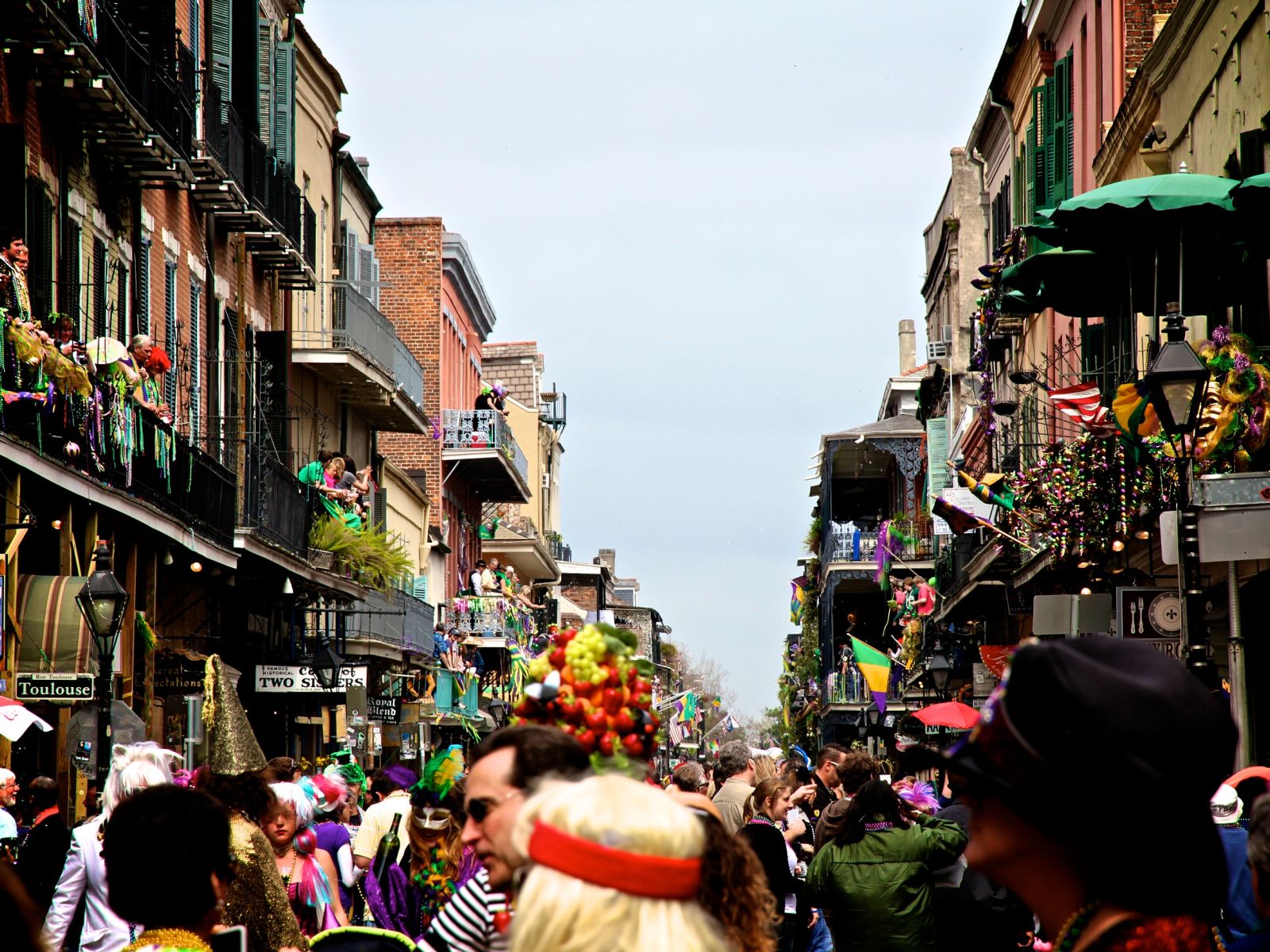
When my friend Kendra asked me to ride krewe with her on a Mardi Gras float I was unsure. We sat at the dining room table of my Seattle apartment one chilly fall night, cradling our wine glasses, polishing off a second bottle of red.
“What about the crowds?” I asked. I hated crowds and had always sworn off Mardi Gras because of them.
“You’re above the crowds on the float,” she assured me.
Kendra, a New Orleans native, rode Krewe of Tucks the year before Hurricane Katrina. Now, 10 years later, she wanted to ride again. Krewes are social clubs that organize Mardi Gras parades, their origins lie in New Orleans secret societies and early city politics. Some are huge: Endymion and Bacchus are festivals unto themselves. Others are niche, like Krewe of Barkus, which is for dogs. Krewe of Tucks, formed by Loyola graduates in the late ’60s, is known for its irreverence, sense of humor and toilet-themed throws. To ride you have to be invited, or ask to be invited, by the krewe.
“How much does it cost?” I asked.
“You pay to ride and then you buy your own beads,” she explained. “You could easily end up spending a thousand bucks or more on beads.” I reached for another bottle of wine. “You don’t want to be cheap with beads,” she advised. “If the crowds don’t like what you throw they’ll throw them back at you. And if you run out before the end it’s embarrassing. It happened to me.” I poured more wine.
“Look,” she said, standing up, grabbing an imaginary string of pearls and throwing them to an invisible parade goer, “think of it as spreading joy.”
I told her I would sleep on it and the next week I mailed in my deposit check. When, I wondered, would I get another chance to throw a thousand of dollars worth of costume jewelry to perfect strangers?
Carnival is a celebration of spring dating back to the Greeks. The Romans turned it into a Bacchanalian orgy. In Renaissance Europe it was a time of aristocratic banquets, masked balls and parades. For Catholics all over the world it is the last blowout before Lent. In New Orleans it is high camp: 12 days of parties and parades culminate into Mardi Gras celebrations where people dress up in costume, wear masks, get drunk and dance in the street.
It is a shared experience of excess that transcends racial and economic boundaries, flipping everyday problems the bird by saying: life can’t be that bad if I am having this much fun. Even the modest Mardi Gras celebration that New Orleans put on six months after Katrina, before hotels had re-opened, before there was even garbage service, boldly showed the world that the Crescent City had survived its near-death experience and was ready to ride again.
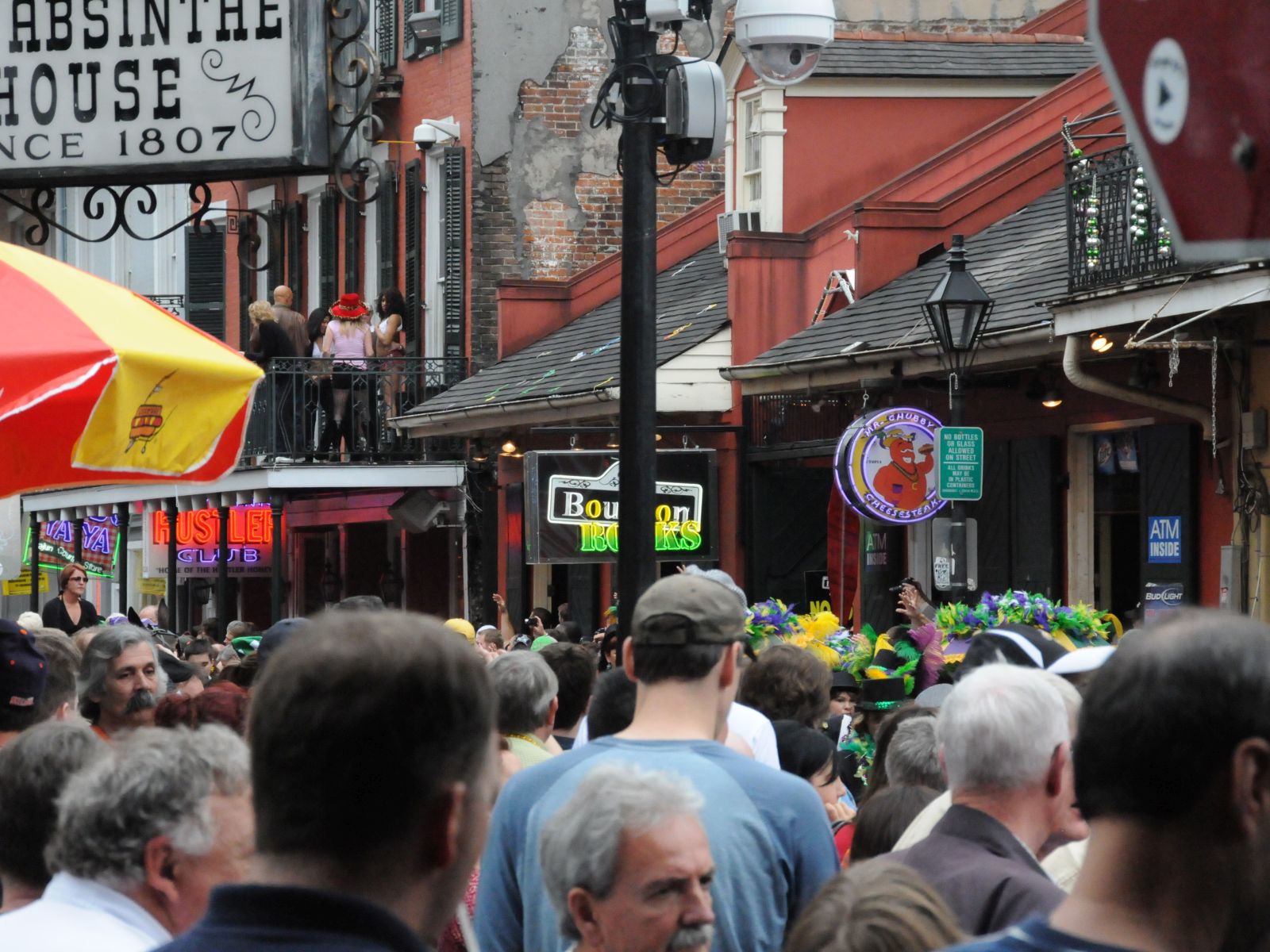
We arrived at the parade starting point on Napoleon Avenue, in New Orleans’s Uptown neighborhood. The mid-morning March sun was already hot, hiding behind a haze of humidity. Brightly colored floats lined the street. A high school marching band practiced hip-shaking New Orleans brass band classics. The Laissez Boys to our right, with their wheeled armchairs, prepared for the parade, bloody marys in hand.
The float was a replica of a casino, and our throwing spot was directly above the “shot wheel” painted on the side. I was already sweating under my purple, gold and green Mardi Gras vest as we began hanging our beads on metal hooks, getting them ready for easy throwing. We had ordered most of our beads online and had them shipped to us. We had bags and bags of them. Some made of large “pearls,” others small, and some made of the tiniest “pearls” of three or more colors braided into a twist.
The day before we had stopped at Mardi Gras Imports to pick up specialty throws for people we really liked: strings of rubber ducks, stuffed snakes and spears. We also had the much sought-after Tucks-branded throws: sunglasses with toilet seats for frames, plungers and toilet brushes. At noon we began to roll. “Rock the Casbah” blasted out of the speakers above us.

Who should I throw to? Everyone yelled for beads but I wanted to be more discriminate in my throwing so I wouldn’t run out. At first I only threw to children. Their eyes would light up when they caught a toss. One man pointed to his child sitting on his shoulders, so I threw her a string of gold beads. Then she handed the beads to her dad. Obviously parents were pimping out their children to get more for themselves. I stopped throwing to children and started throwing to people who didn’t have many beads. I saw a woman sitting on the ground who seemed to have no beads at all and I threw her a strand of silver globes. She smiled and immediately squirreled them away into the bag of beads at her feet.
Eventually I gave up on a strategy and began throwing to anyone who looked nice, friendly or interesting. Someone I would want to hang out with at home. One woman looked dejected, her friends were having fun than she was. I made eye contact and tossed her a double-twist. Her eyes lit up and she gave me a big smile. An electric instant between two strangers! Like I’d given her the best surprise gift ever.
Fling, fling, fling!
The float turned onto St. Charles Avenue and headed downtown. Purple and gold beads hung in tree branches from previous Mardi Gras parades. We passed grand Garden District balconies filled with bead-adorned revelers holding champagne flutes and screaming, “Throw me some beads!” People knew what they wanted and would ask for it. One reveler locked eyes with me and pointed to the string of rubber duckies he wanted. What could I do but oblige?
We continued moving towards downtown, crossing streets named for the Greek Muses: Terpischore, Thalia, Erato, Clio. The crowds grew bigger after every intersection.
The crowds always wanted more: more doubloons, more double twists. “You got any plungers left?”
When the crowd got too demanding I would sit down, hidden from the crowd by the wall of the float, take a breather and a few gulps wine from my sippy cup.
As we neared downtown I realized I’d been throwing beads too sparingly, I’d been too picky. By Lee Circle, the halfway point, I still had bags and bags of throws left. I began throwing by the fistful.
Fling, fling, fling!
Entering the downtown business district the crowds were thicker and barricades appeared. I could no longer make eye contact; I had lost my human connection, but I had way too many beads left. I threw like my life depended on it, like I was on the sinking Titanic and jettisoning ballast would help me to survive.
We turned onto Canal Street, with its colonnade of Royal Palms. At Chartres Street, the entrance to the French Quarter, the ride was over. I was hot, comfortably drunk and disoriented as I left the float. I still had three large bags of leftover beads.
Not knowing what to do with them I walked down to the sidewalk and set them on the pavement. People would love them, I thought. But nobody noticed. People walked around them. They were just like the other beads, broken from throwing, strewn all over the sidewalk that nobody would pick up. Without the human connection on the other end, without a person spreading joy from the top of the float, they were just beads. Plastic. Joyless. Made in China.

[Mardi Gras 2011 by Brad Coy/Flickr; Mardi Gras by Larry Johnson/Flickr; Mardi Gras Beads by Author]
 A notebook, a camera, and a penchant for exploration have been in Mark’s knapsack from a young age. A business consultant in Seattle, Mark travels as much as he can get away with and writes about it on his blog, WilderShores.net.
A notebook, a camera, and a penchant for exploration have been in Mark’s knapsack from a young age. A business consultant in Seattle, Mark travels as much as he can get away with and writes about it on his blog, WilderShores.net.
The post Spreading Joy At Mardi Gras appeared first on The Expeditioner Travel Site.
]]>The post Learning To Befriend Winter In Quebec appeared first on The Expeditioner Travel Site.
]]>
On the narrowest stretch of the trail, hemmed in by forest, Fripouille locked his icy-blue eyes onto me. “Hey, why aren’t we moving?” he seemed to be asking. Not that he could ask me as much. Fripouille (Scoundrel in English) was one of six Alaskan huskies standing in front of me, howling in cacophonic impatience. I gripped the bar of the wooden sled and kept one foot on the brake lever, as I had been instructed by Antoine Simard, the energetic manager and dogsledding trainer of Expédition Mi-Loup on Ile d’Orleans, a few miles downriver from Quebec City.
It was my first time on a dogsled, and I didn’t know how to answer Fripouille, because in this moment, I was also experiencing my first dogsled traffic jam.
Several dogs pulling the sled in front of us had stopped on the side of the trail for a bathroom break. But these dogs were pros at pooping on the run, and had finished before another bark could crack the crisp breeze crossing the island. I lifted my foot off the metal brake. The clanking sound was all Fripouille and company needed to send them trotting, even before my wife, sitting in the sled’s only seat, could shout “allez!” (go!).
And then, gracefulness in motion: six furry tails waving in unison; tongues flapping and steaming. Our faces smacking cold, clean air while traveling fossil fuel-free. No, it wasn’t the Iditarod, but we glided at a comfortable pace that allowed us to absorb views from the trail that first passed through snow-burdened evergreens and then rose up to the island’s naked spine.
And that was part of our plan. My wife and I live in New York City, where we find winter little more than a nuisance of slushy, un-shoveled sidewalks and brusque exchanges — something that just has to be tolerated. We wanted to learn how to look past that limited and unfortunate view of a season. To do that, we had decided to travel to a place where winter is bolder and longer, where winter is not merely tolerated, but also put into one’s service, even embraced.
But first, I had to let an illusion die. I have always wanted to shout a particular word, a syllable that sends muscle into action: mush! The word owes its existence to the peculiar topography of Canada’s bilingual legacy that began with French dogsledders shouting the command marche (“go!”) to their dogs, which became bastardized in English as “mush.” I wanted to feel that history, experience it, pass it on.
Alas, the word has mostly fallen out of use. “It doesn’t matter if you say mush, marche, allez, whatever. The dogs won’t move,” Antoine had told us during our briefing. “The dogs hear the brake release noise as their signal to run.” His buoyancy defied the morning’s chilly gusts, the flaps on his hat up, his beard keeping his face amply warm.
My mushing fantasy had not fallen completely through the ice, however. The word “mush” reentered French, naming the person who drives the dogsled: le musher. In a charming tangle of Canada’s sometimes antagonistic history of language, the word musher is the same in English. This made me a musher, no matter what language I speak.
Fripouille led us back to our launch point outside Auberge Le P’tit Bonheur, an inn that occupies a stone and wood building older than the word musher. Alaskan huskies, their thick fur in the subdued hues of frigid wilderness, distinctly resemble the wolves of their ancestry, but I never knew they were world-class cuddlers. A few strokes along the deep warmness of their neck fur sent them into a nuzzle frenzy, almost knocking me over. An aura of husky musk became our wearable souvenir.
Antoine manages 160 sled dogs and 60 puppies, not one of them named after a real person. Fictional characters, however, remain fair game. When he mentioned that one is named Homer (as in Bart Simpson’s father), I suspected Homer might have been in the back row of our sled team, since he kept pulling to the side of the trail to chomp indulgently on mouthfuls of snow like doughnuts.
The Slow Squeeze
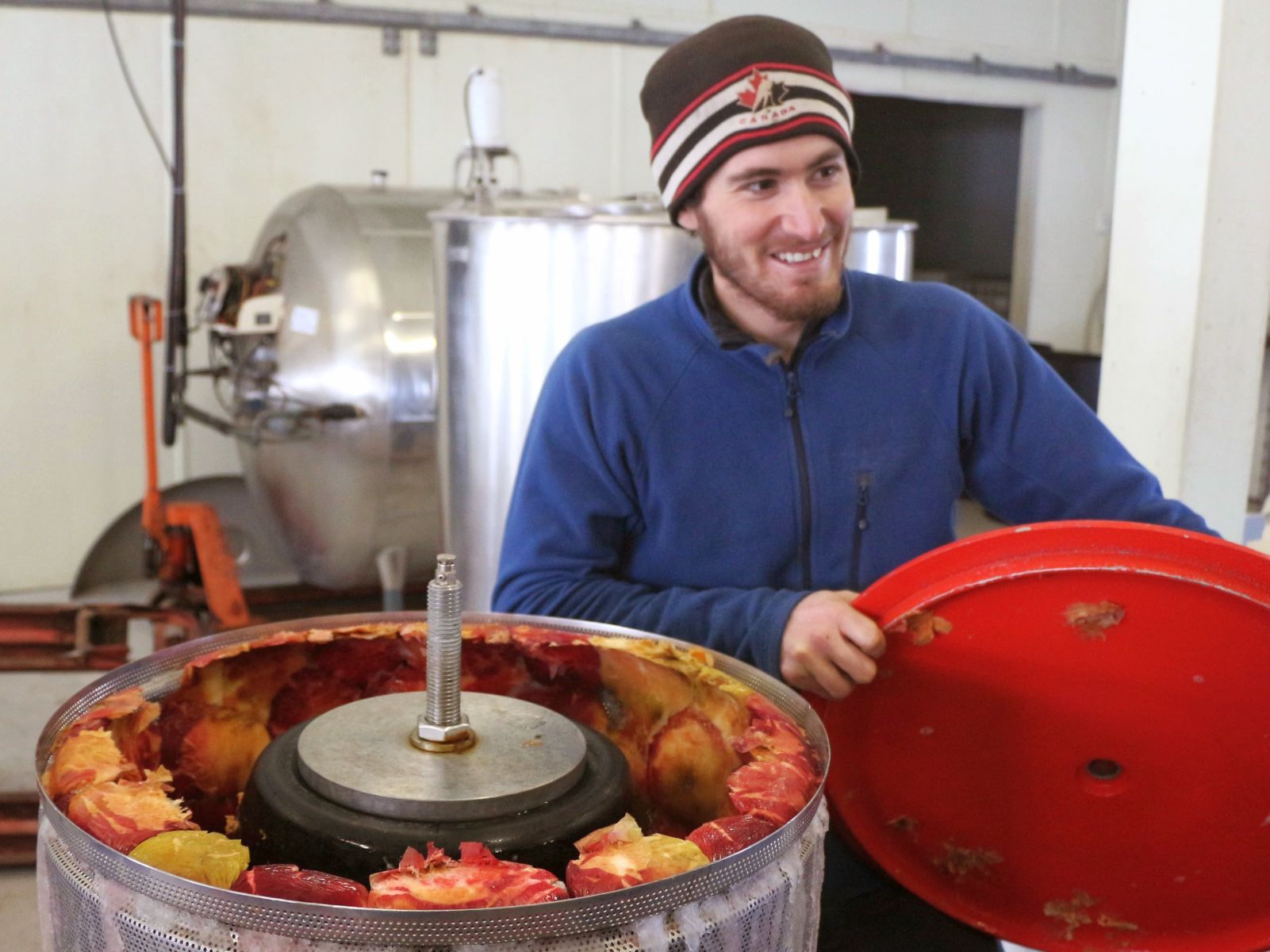
A few days before, we’d traveled to the other side of Ile d’Orleans to visit the orchard of Domaine de la source à Marguerite, where winemaker Conrad Dion offered us a peek at the process of pressing frozen apples to make cidre de glace — ice cider, a specialty of the region.
In the winery’s garage-like workroom, Conrad and his assistant Jean-François, both in rubber boots and knit caps, plugged their fingers in their ears, exaggerating the pose as if a cartoon bomb were about to explode, insuring my wife and I mimicked them. Jean-François opened a valve on top of a cylindrical press, inside of which a thick-walled rubber balloon shot out a fierce hiss, releasing its 50 pounds per square inch of pressure.
Jean-François removed the metal lid from the press to reveal hundreds of flattened apples, still frozen, stuck to the outer wall. The syrupy juice had emerged from tiny holes on the outside of the press, as if it had been sweat out.
Why press the apples frozen? As with pressing frozen grapes to make ice wine, pressing frozen apples produces a concentrated juice because more of the liquid stays behind as ice. The process results in a sweeter, more coveted prize, owing to the higher sugar content, so long as the climate reliably provides a season-long deep freeze.
Jean-François passed me a hydrometer, a device like a pirate’s spyglass. I peeked inside to find a blue line almost off the scale: 34 percent. Was the blue line the sugar percentage? “Oui,” Jean-François answered, his Quebecois accent shaping the word into a casually clipped “weh.”
My wife and I had already been familiar with ice cider’s allure. Four years before we got married on the island and served a case of Domaine Marguerite’s ice cider to our guests during dessert. One of our guests made her particular fondness of the beverage known by announcing, “Ice cider is my new boyfriend!” in front of her boyfriend.
I had imagined I’d hear a percussive concert of shattering frozen fruit during the pressing, but it proved to be much less dramatic. The pressing requires about an hour, depending on the outside temperature where the crates of picked apples are stored. The only sound from the press, aside from its brief wail of sibilance when deflating, was a gentle, therapeutic trickle of thick juice falling into a tray.
The juice would then ferment for six weeks before being bottled. But time is not the only laborious factor. Conrad told us that 80 apples are needed to make one 375 milliliter bottle.
“Quatre-vingt pommes? (eighty apples)?” I asked, insuring my basic French skills hadn’t deceived me.
“Weh, weh.”
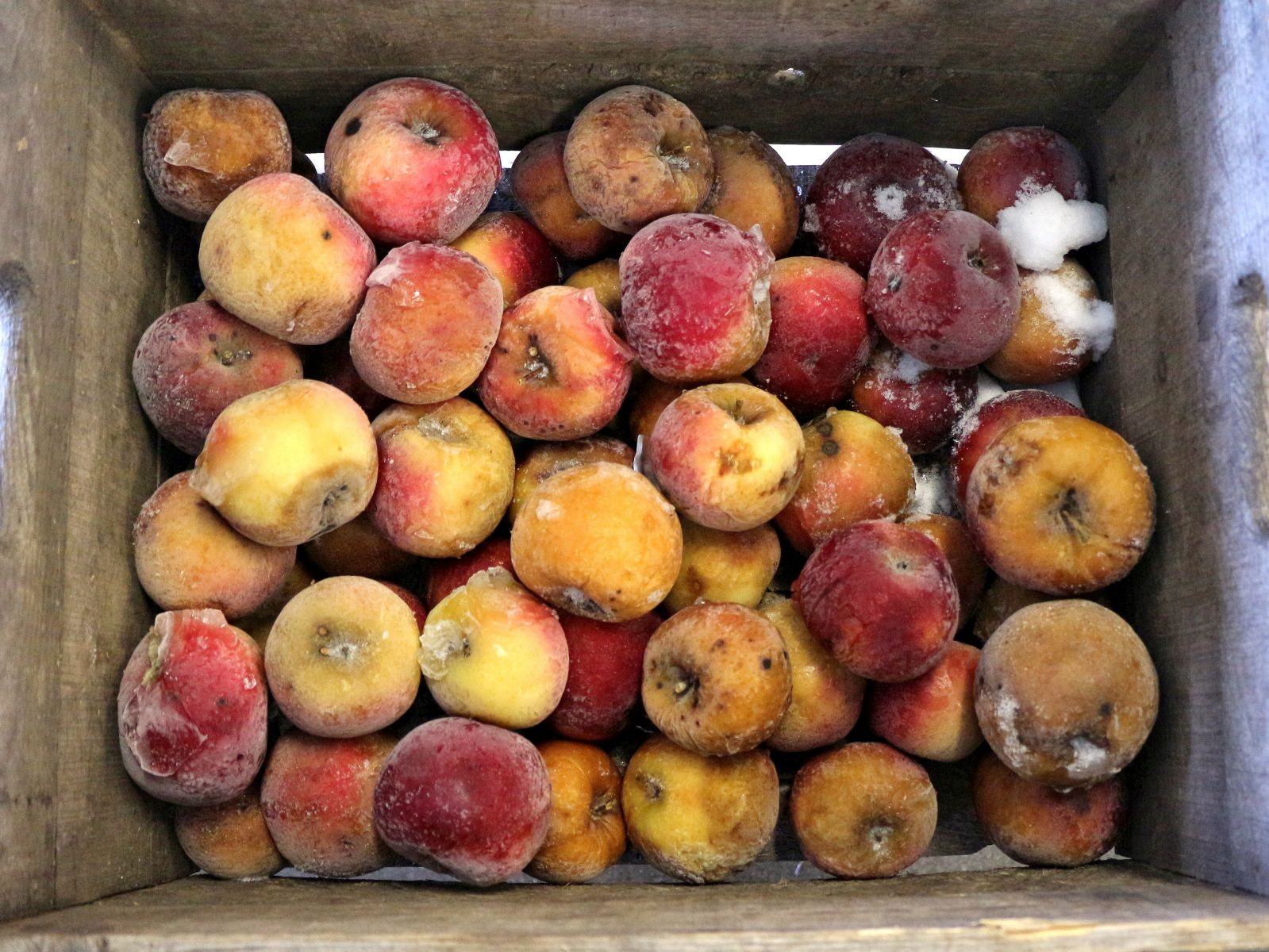
Across the road, a few apples, having turned orange and glistening as if candied, still dangled off bare black branches. “We left a few apples for the birds,” Conrad said. I picked one. It felt as hard as a billiard ball. I reckoned the birds needed ample patience — and strong beaks — to snack on these natural juice pops.
Domaine Marguerite’s ice cider has won numerous awards in competitions held in the Finger Lakes region of neighboring New York State, a feat more admirable considering that Conrad and his wife have only been making ice cider since 2001. But that is a long time in ice cider years. Frozen apples were first pressed in the late 1980s in the southern part of the province, the resulting creation following poutine as another Quebecois culinary invention.
Budding winemakers from milder climates take note: cheating by putting fresh apples in a freezer will fail. Apples must be kept outside to allow air to freely circulate around them, preserving their flavor, that modern flavor of the Quebecois winter, of oenological ingenuity, of boyfriend replacement.
Sleeping with the Moai
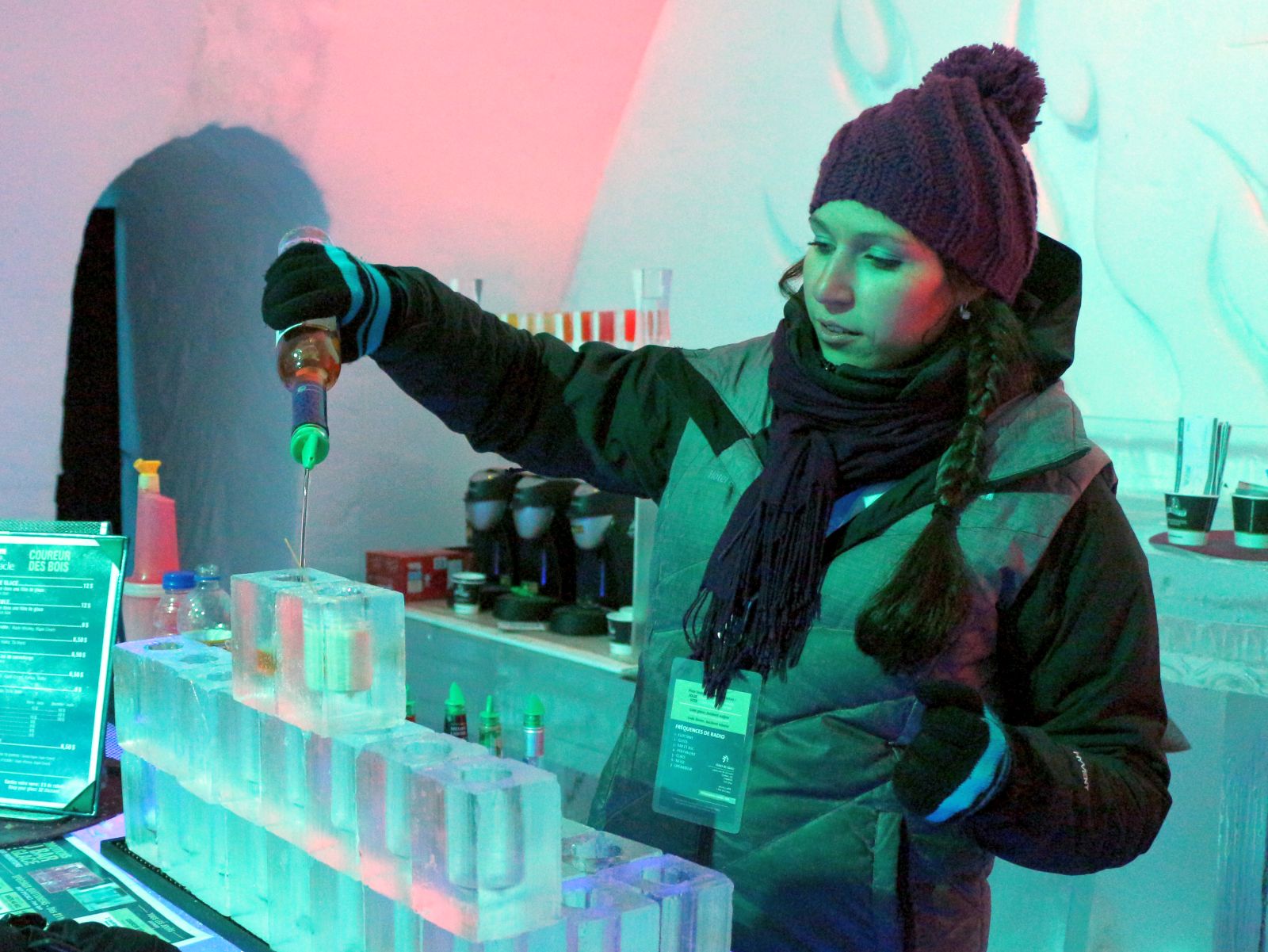
Ice cider appears on drink menus at many restaurants in nearby Quebec City. Flute glasses of ice cider commonly accompany ris de veau (sweetbreads), cheese plates, and crème brûlée. Our next serving of ice cider arrived the following evening at the bar of Quebec City’s Hôtel de Glace, the only ice hotel in the Americas.
Located on the grounds of what used to be a zoo 10 minutes north of Quebec City’s old town, the single-level ice hotel was constructed out of 25,000 tons of snow and ice: vaulted walls, chairs, the bar, everything. That total doesn’t count the daily requirements of the bar that serves drinks in glasses made of ice. Thankfully, I avoided the awkwardness of a Christmas Story moment because alcohol freezes at a temperature lower than water, thus my lips didn’t stick to the glass.
We didn’t stick to the ice pews in the hotel’s non-denominational ice church either. Each pew was draped in a quilt, insulating us from the ice but still allowing the seat to exude a mandatory hardness expected of church seating. With clear ice posts and a packed snow vault reaching over 20 feet high, the ice church seemed to be a place where it was acceptable, even encouraged, to keep the sermons short and sweet.
“We have 40 weddings here each year. We even had one wedding where the groom was a Scotsman who walked down the aisle in traditional Scottish clothing. Know what I mean?” announced our guide Caroline Lafrance from her fur-ringed parka hood. While my half-frozen lips had turned my pronunciation skills into a slur-fest worthy of a wino, Caroline’s speech remained almost flawless, the temperature unable to affect her joke deliveries.
Several of the hotel’s 44 rooms showcased one-of-a-kind sculptures by 15 artists. The Pegasus room featured a 10-foot-high packed snow carving of the winged stallion on a wall. Thick-bodied moai towered over the bed of the Île de Pâques (Easter Island) room.
Two of the rooms featured fireplaces. But guests needed not worry about melted walls collapsing on them as they enjoyed the fireplace’s glow. “They warm your heart, not your body,” Caroline announced. The custom-built fireplaces, though metal-framed — the only metal I’d seen in the ice hotel — are doubly insulated so the heat quickly rises up the vent and out of the hotel, allowing the flame’s gentle flicker, but not its heat, to mesmerize guests.
The construction of an ice hotel could only succeed in an environment that falls under a prolonged deep freeze. All those brief, delicious, spring-like warm-up periods we New Yorkers savor during our winter would spell doom for an ice building. The only melting with which we needed to concern ourselves was known as the rookie’s ring. “Don’t leave your ring on the night table in your room,” Caroline warned. “The ring is warmer than the ice and we will have to chisel it out in the morning.”
In addition to chisels, the hotel’s maintenance crew kept an arsenal of tools specifically suited to ice-based architecture. I occasionally saw a three-man crew passing me in the halls with a wheelbarrow of snow and a couple shovels. I imagined they are the ones tasked with covering the handiwork of snickering couples who have carved their initials into the walls.
We walked to the hotel’s Celsius lounge, a separate, heated building to the side of the hotel, where we stored everything except the clothes we needed for sleeping. We received instruction on how to survive in our room overnight: cotton clothing traps moisture, making you feel cold, thus is your enemy; change your clothes while inside the sleeping bag to prevent heat from escaping; the sleeping bags are rated to -22 degrees Fahrenheit, but the rooms remain at a steady 24 degrees, so you may sleep naked if you wish (the sleeping bags are washed every day).
Ice, especially the custom-made, bubble-free, crystal clear ice used by the ice hotel’s sculptors, would have presented a privacy issue, so the walls were fashioned from packed snow almost a yard thick. The hulky, vaulted shell surrounding us made me feel as if we had hunkered down in the catacombs of a church, or a dungeon turned condo — the ultimate in creative urban renewal — complete with a mattress atop an ice platform.
The experience seemed to straddle the unlikely territory from camping to backpacking to luxury fantasy. But the night’s intense quietness struck me the most. Once zipped up inside the sleeping bag, I heard nothing but the rhythm of our breathing and the occasional chiming crackle from ice forming and melting on the outside of my ski mask, just below my nose.
Along the way, we learned the best way to make a bathroom run, a journey that involved walking to a heated outhouse outside the hotel: quickly.
Cold Enough for a Parade
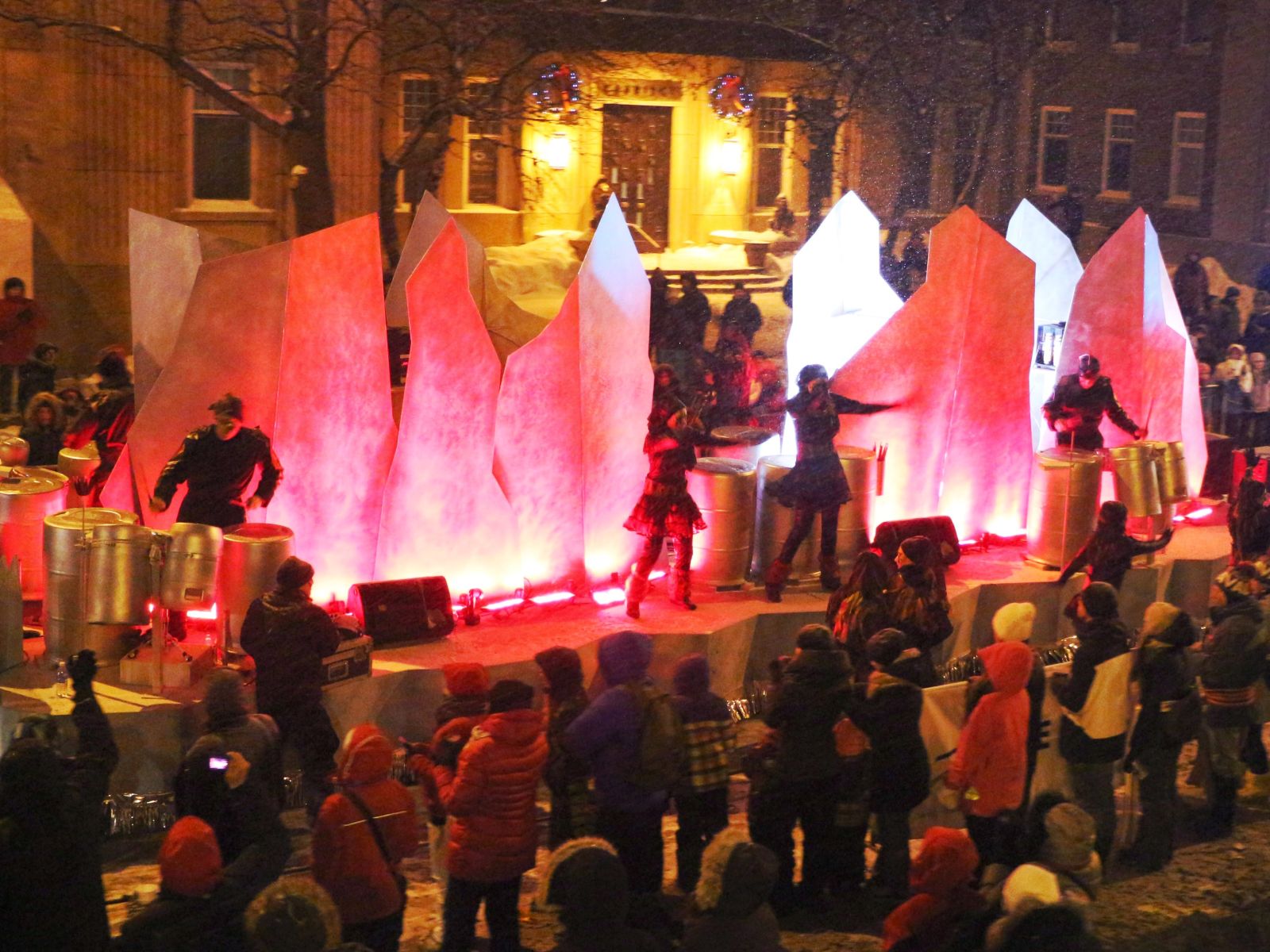
The next night, in the sloping streets of Quebec City’s walled old town, we encountered something that normally fills New Yorkers with dread: snowy, slushy sidewalks. The folks of Quebec City turned the situation to their advantage by pulling along their young ones in sleds, saving the tots the hassle of slipping and falling down.
The residents and storeowners with shovels in hand wore the same crumpled grimaces of snow shovelers everywhere: the “just get it done” face. But in Quebec City, shoveling served to better expose dozens of ice sculptures on the sidewalks, rivaling the ice hotel’s selection. A hockey player in mid-pass, a beaver, a miniature Eiffel Tower, a mannequin modeling a t-shirt — these were just a few of the pieces fronting stores and restaurants, as if a vigorous competition for creating the most enticing sculpture had seized the city.
Quebec City saw no reason to limit itself to a single ice bar. Several nightclubs, including a drag cabaret venue, had built ice bars on the sidewalk, heat-free LED lights illuminating the carved contours of the counters with slowly changing colors.
Just outside the city’s 17-Century fortified wall stood a 30-foot-high ice castle, perhaps taking inspiration from the former. The structure, complete with a jagged parapet, seemed to fulfill a Lego builder’s dream, one where the rare and coveted clear windshield bricks are unlimited.
At night, the temperature sunk to 5 degrees Fahrenheit and gusts of snow were greedily biting at every inch of exposed flesh. What is a city to do when confronted with such climatic challenges? Why, hold a carnival parade, of course.
For Quebec City’s 60th annual carnival celebration, the city closed down the Grande Allee, the city’s widest avenue, for a procession of marching bands (gloves optional), creepy avian-themed stilt-walkers and trailers full of oil-drum percussionists and carnival dancers wearing more clothing than their New Orleans counterparts, but otherwise matching the American city’s delicious dance steps move for move.
Acrobats tumbling onto a float-bound trampoline mocked the temperature with shorts over skin-colored leggings. I noticed that most of the Quebecois stayed put and savored every somersault and tight drumming riff. We remained in the gusts as long as we could stand, but eventually, we wimped out and sat in the provided warming station (a yellow school bus with the heat turned on) for a while.
It looks like our education in embracing winter is not yet complete. I think we might have to return next winter for another lesson.

/
 Darrin DuFord is a travel writer, mapgazer, and jungle rodent connoisseur. He has written for BBC Travel, the San Francisco Chronicle, Roads & Kingdoms, Gastronomica, and Perceptive Travel, among other publications. His work appears in Stories of Music, a multimedia anthology released in November 2015 by Timbre Press. Follow him on Twitter at @darrinduford.
Darrin DuFord is a travel writer, mapgazer, and jungle rodent connoisseur. He has written for BBC Travel, the San Francisco Chronicle, Roads & Kingdoms, Gastronomica, and Perceptive Travel, among other publications. His work appears in Stories of Music, a multimedia anthology released in November 2015 by Timbre Press. Follow him on Twitter at @darrinduford.
The post Learning To Befriend Winter In Quebec appeared first on The Expeditioner Travel Site.
]]>The post Here’s What It Was Like Attending Colombia’s Craziest Festival appeared first on The Expeditioner Travel Site.
]]>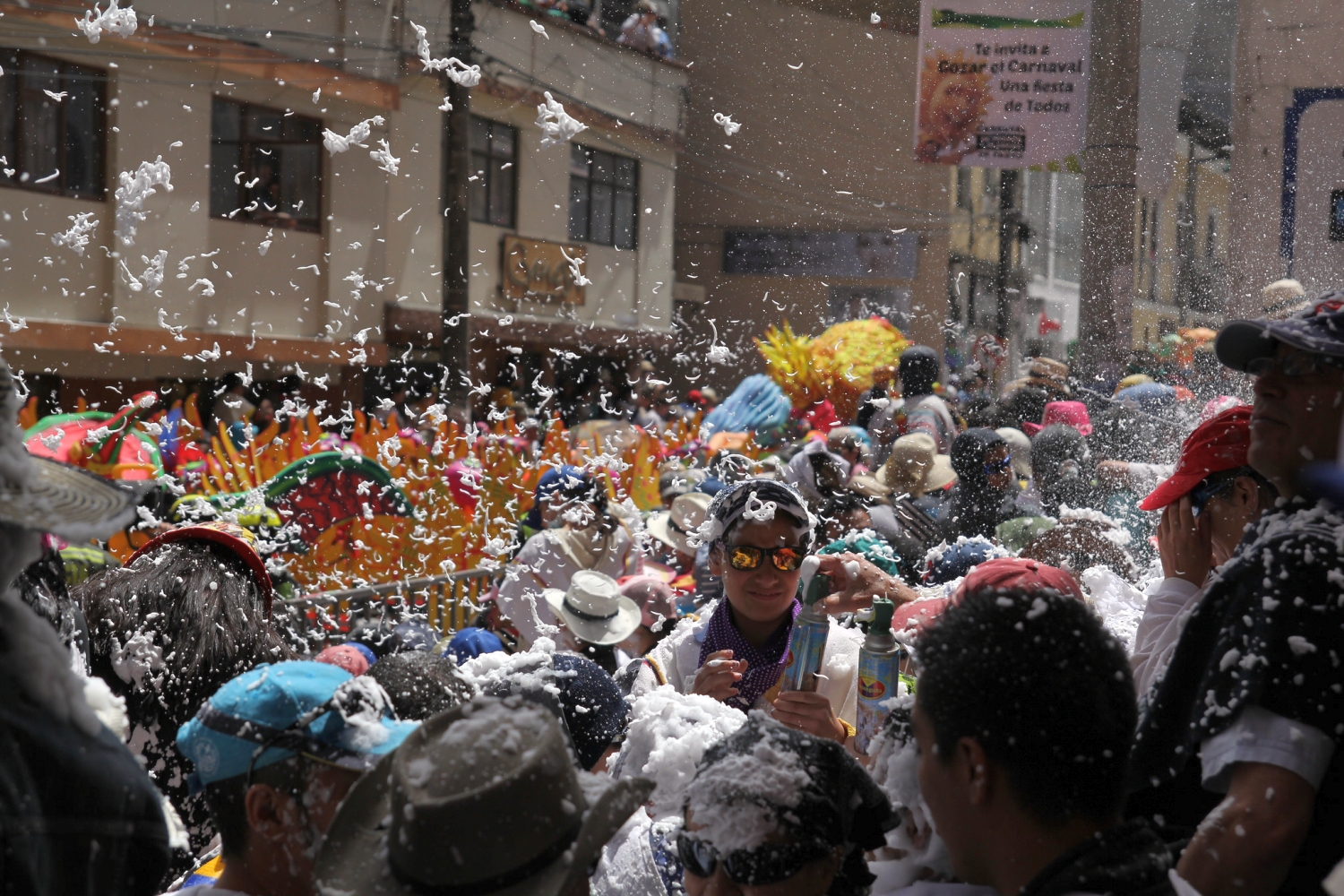
All the babies are crying, and an old lady starts yelling hysterically. As an enormous burst of turbulence turns my stomach sideways, I catch the eye of a man who looks like Gabriel Garcia Marquez. He gives me a gruff nod and half-smile, as if to assure me that the landing is always like this. I’m not convinced. Looking out the windows on both sides, men shout distances up to the cockpit, as if they were helping a neighbor parallel park. “10 meters!” “15 meters!” They are estimating the distance between the wingtips and the green peaks of the Andes. And the numbers they’re using are disturbingly small.
Though it wasn’t in the brochure, this is my introduction to the three-day, non-stop adrenaline rush that is the famous Carnaval de Negros y Blancos. Shaking a little bit, I step out into the one-plane airport of Pasto, Colombia, very near the Ecuadorian border. Now that they no longer herald a death stung by bits of fiery fuselage, the Andes are really quite beautiful. I even start to relax as I pass through the tiny terminal to the taxi stand. But there’s an ambush in place outside the airport. A group of teenagers cackle as they strafe the line of expectant family members and private taxi services, each armed with two cariocas, the basic-issue armament of the Carnaval participant. They are long, narrow aluminum cans containing something akin to shaving cream. I duck behind an old woman who takes the brunt of the fire. This will prove to be the only time I feel ashamed about using the elderly for protection. With their broad frames and slow movements, they really do provide the best cover.
After a harrowing hour-long taxi ride down a one-lane highway cutting through the mountains, where cars break through into oncoming traffic at blind turns with total impunity, I am finally in Pasto. The city itself, though small, is incredibly beautiful. Couched in the green mountains, under the watchful eye of an enormous dormant volcano, it has been a pilgrimage site in the area for hundreds of years. It’s full of historic churches, and this day of the carnival celebrates this element of the region’s culture. January 4 is the day commemorating the arrival of the Castañeda family, a pack of oddballs who passed through on their way to the Las Lajas sanctuary to the south. There’s a parade packed with men dressed as schoolgirls and women dressed as barbers prancing about as floats depicting confused children celebrate the general weirdness of people who pack up their families and walk hundreds of miles to look at a church.
It’s getting dark as I step out of my hotel to take place in the nocturnal revelries. I’m wearing my nice shoes and nice jeans, and don’t even think twice about it. I’ve read the Wiki on this thing. Today there’s a nice parade, tomorrow we’ll paint each other black, and the last day we’ll throw talc and foam and make a mess — the assault on the airport was an isolated incident. Tonight should be good clean fun.

Like all good festivals, the Blacks and Whites’ does not abide by its own rules.
I’m no more than ten steps outside my hotel when a family with two children eyes me head to toe in bemusement — we’re early in the carnival, and most tourists won’t arrive until the 6th to see the great parade, and even then they are not often American — before they each whip out the cariocas from behind their back and douse me from head to toe. While I’m desperately trying to clear the foam from my eyes, nose, ears and mouth, a window rolls down from a passing car and a talc-bomb catches me square in the chest. The doorman of my hotel laughs devilishly as I look around, trying to figure out what just happened.
One block further and a group of concerned-looking teenagers approaches me. Seeing how unprepared I am, they take pity and buy me my own carioca as well as a pair of sunglasses — the foam can sting your eyes, they explain to me. “No shit,” I tell them in my best Spanish. I follow them on their route, glad for the protection a few extra bodies can afford.
But their good nature is short-lived, or maybe entirely a ruse. They accompany me like bodyguards for a short time, leading me into the middle of one of Pasto’s two large squares dedicated to the carnival. As we push through throngs of people, I try to memorize the way back to my hotel, constantly wiping foam off of my sunglasses. Just when we reach the heart of the beast, the kids loudly call attention to my gringo presence. I will never see them again, as it takes nearly ten minutes to de-foam and de-talc myself, blindly stumbling through thousands of people to find shelter. This is the nature of warfare in Pasto.
The next day, the 5th, is the Blacks’ Day. I’ve planned a route for a morning stroll, hitting many of Pasto’s beautiful cathedrals and sanctuaries and also scouting out a good spot to view tomorrow’s Great Parade. I wear the same clothes, my battle gear, which will become impossibly ruined. With some paranoia I skulk about, peeking around corners, keeping an eye out for adolescents with cariocas. But they are still asleep, and the first to rise are the kind ones, the elderly and families with young children, who want to enjoy themselves before the mayhem starts.

I take a moment to breathe the cool, mountain air. A group of Colombianas, giggling, points me out. They turn around, conferring, then one of them slowly strides up to me. I stand stock-still; my conception of the carnival was more or less receiving undue attention from beautiful Colombian girls while parades and parties took place in my peripheral vision, and it seems to be coming true. She comes in for a kiss, cradling my face in her hands. There is a cold, oozing sensation, and as she pulls away before making contact I realize that her hands were overflowing with black paint. The 5th is officially in full swing as each of her friends more or less slap me with a handful of the same.
Later in the afternoon my cousin and photographer Jordan arrives in town. His wide-eyed expression and foam-covered bag communicate that he’s had a comparable experience to my own arriving into the city. We stroll around, paint and get painted, drink beers and talk with various groups, and enjoy warm Andean hospitality. Then, suddenly, the debauchery switches on. We come to realize that all the descriptions of the festival are true until about three in the afternoon, when the fabric of society dissolves under the chemical duress of 20 tons of shaving cream. Street vendors who have been hawking cold beers now change to aguardiente, the local anise-flavored liquor. The painting changes from delicate strokes by attractive women to more intrusive attacks. A boy no more than 12 years old sneaks up behind me and gets my whole nose and mouth with blue paint, which I will taste for a week. And then the cariocas come out.
Back at the hotel, we ask the security guard if it can get any crazier. He has worked outside the hotel every Carnaval for five years, which makes him a sage old veteran deserving of his epaulettes. He laughs at us. “Oh, that’s nothing, compared to tomorrow. You’ll want to buy a mask for your nose and mouth.”

And he’s absolutely right. The next day, the 6th, is the Whites’ Day and also the day of the grand parade, which starts early and goes for five or six hours under the hot sun. In Spanish it’s the Gran Desfile, which reads to American eyes like the Great Defiling, which is more or less what it is. Aguardiente hits the streets before the sun, and people who have grown impatient waiting for the parade to start get in massive carioca, flour and talc fights. Clouds of white massive enough to blot out the sun become a regular affair. It’s a study in the chain reaction — one sour look, one misfire of a carioca and suddenly a whole city block looks like the local Gillette factory had an accident. Tourists and the police patrolling the cordons are particular targets, though with so many people packed into such tight areas it is difficult to aim accurately.
Finally, the parade arrives. This is the reason why the festival is commemorated by UNESCO as a masterpiece of intangible cultural heritage, and it does not disappoint. Hundreds, perhaps thousands of colorful floats that have been the whole year in the making pass by, gradually increasing in size from enormous heads mounted on the shoulders of grunting, sweating men to converted buses and sixteen-wheelers. These are punctuated by musicians, dancers, circus performers, and scantily clad Colombianas.
There are nearly half a million people taking it all in, packed tighter than sardines, hanging from second-story balconies and sitting on towels wrapped over razor-wire walls. 50-pound paper mache political candidates box one another while KISS cover bands play local Andean music and women distribute smooches and candy. Marquez, who passed earlier this year, receives special attention with two or three large floats in his honor. The people are amazingly kind — people buy us beers wherever we go, Jordan and I finally get our Colombiana kisses, and we enjoy short-lived celebrity status. Mothers take pictures of us holding their babies. We each acquire about a dozen penpals. It’s paradise, until the sun starts to dip. Everybody knows what that means, including us. The rules that hold this fragile peace together will soon crumble. The apocalypse is coming.
Fearing the end of days, we spend our last night at a salsa bar three stories above the main plaza. Looking down, we can see nearly 50,000 people, which puts my first night of terror in perspective. Live concerts of a salsa-reggae mixed genre blare out at a hundred decibels. Generally, a salsa bar is a good place to hang out off the beaten track in Colombia. All the girls want a dance, and we embarrass ourselves thoroughly — “Remember, it’s just one-two. Don’t get fancy.” Occasionally, we lose sight of the crowd as a dusty white cloud permeates the square or a snowball of foam manages to make it up 30 feet to our position. But that’s the Carnaval. Cover your ears, your eyes, and your drinks.
And with that, the festival is over. We creep out on the 7th in our battle gear, expecting the same no-rules surprise attacks as the previous three days, but we look like fools. Everybody is dressed in business clothes and nicer casual-wear, nobody has sunglasses, and most of the destruction has already been washed away in an ever-swelling river of chalky talc and flour. An old woman leans up against a tree, bracing herself — she has an actual fire hose over her shoulder, and she is power-washing the façade of her fabric store. Her stream joins the rest of the white water, which will flow downhill into the ravines of the Andes, carrying away the last trace of the confluence of blacks and whites until next year.

 Jordan A. (left) works as a web manager for Deseret Digital Media in Salt Lake City, Utah. He studied journalism and political science at Utah State University. Ski Krieger (right) is a physicist and writer based out of Providence, Rhode Island. When working or not, he’s steadily warbling as he prepares to compete in throat-singing competitions in Tuva.
Jordan A. (left) works as a web manager for Deseret Digital Media in Salt Lake City, Utah. He studied journalism and political science at Utah State University. Ski Krieger (right) is a physicist and writer based out of Providence, Rhode Island. When working or not, he’s steadily warbling as he prepares to compete in throat-singing competitions in Tuva.
The post Here’s What It Was Like Attending Colombia’s Craziest Festival appeared first on The Expeditioner Travel Site.
]]>The post The Colors Of Holi appeared first on The Expeditioner Travel Site.
]]>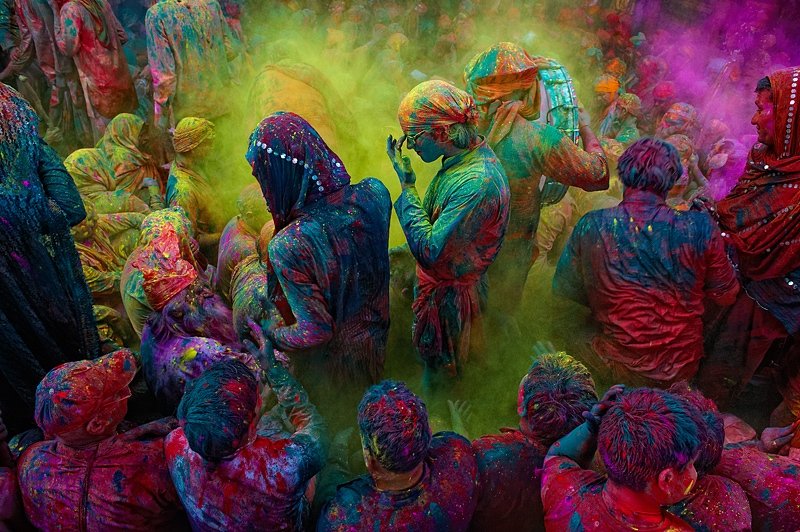
Holi, known as the festival of colors, will be celebrated this Monday in many parts of the world, including India, Nepal, Suriname, Trinidad and Tobago, Guyana and increasingly, throughout much of the rest of the world (especially those areas with a large Indian population). The date varies every year (it falls on the last full moon day of the lunar month Phalguna), and the festival marks the end of winter and the onset of spring, and symbolizes the victory of good overcoming evil.
The two main rituals associated with Holi are the burning of an effigy of Holika (in the Hindu religion, Holika was the evil sister of demon king Hiranyakashipu who attempted to trick her nephew into being burned on a pyre to punish him for disobeying his father), followed the next day by a celebration of colors, resulting in the many colorful images of Holi seen every year.
[Holi via Vixolo]
By Matt Stabile

ABOUT THE AUTHOR
 Matt Stabile is the founder and Editor-in-Chief of TheExpeditioner.com. You can read his writings, watch his travel videos, purchase the book he co-edited or contact him via email at any time at TheExpeditioner.com. (@TheExpeditioner)
Matt Stabile is the founder and Editor-in-Chief of TheExpeditioner.com. You can read his writings, watch his travel videos, purchase the book he co-edited or contact him via email at any time at TheExpeditioner.com. (@TheExpeditioner)
The post The Colors Of Holi appeared first on The Expeditioner Travel Site.
]]>The post I’m Pretty Sure Colorado Is Turning Me Into A Hippie appeared first on The Expeditioner Travel Site.
]]>
The Problem
After two years of living in Boulder, it’s easy (albeit somewhat embarrassing) to see how much I’ve imbibed in the Republic’s Kool-Aid.
Within a month of being in Colorado, I realized that I have nowhere near enough gear. Upon arrival, I immediately bought a road bike. I’ve been a proud owner of not one, but two Epic Vail ski passes. Furthermore, without proper camping gear, my social life would be nonexistent. I added a tent, a sleeping bag and a sleeping pad to my quiver of supplies.
I readily extol the virtues of Subarus, Birkenstocks, Australian Shepherds, kale and legalized marijuana to anyone who will listen.
Fueled by the plethora of Boulder-based startups and PhD candidates meandering about on Pearl St., I’ve also adopted a restless spirit of entrepreneurial distress. More than once I’ve woken up in a cold sweat, heart beating hard, wondering why I haven’t launched my own company yet, written a book or attained a degree in optical engineering.
Do you want to know my deep, dark secret? I feel a nagging pressure to be outstandingly amazing. It’s difficult to shake the feeling that there’s always something better — something more intelligent, more philanthropic — that I should be working towards. Along with the camping supplies, the Subaru and the bike, my dear Boulder has made me so friggin’ anxious about an unwittingly wasted potential.
The Result
So in true Boulderite fashion, I recently quit my gym and joined a yoga studio.
I had taken yoga before to get in shape — little else worked my arms and legs so hard. And being more flexible is beneficial for running, hiking, biking, etc . . . But after two months of taking yoga classes almost every day, something odd happened: I felt a shift. I didn’t just understand what my yoga teachers were saying during asanas, I embodied it. For example, chanting “om” at the beginning of class is no longer an embarrassing cliche that I try to avoid, but a grand, unifying gesture that severs the outside material world from the inner one — the world on my mat and the world inside me.
Practicing yoga helps me realize something higher that I have always known was there, but never had the avenue to access. I’m not talking about God. I’m talking about a deeper way of communicating with myself and with the natural world. (Oh my, if that sentence wasn’t forged by the mind of a hippie . . .)
Now I can’t get enough of yoga.
Next week, I plan to hone my new-found yogic zeal by attending the Wanderlust Festival, taking place at Copper Mountain. I’ll relax, I’ll meditate, I’ll hike, I’ll dance to music, and obviously I’ll take lots of yoga classes with names like “Groundation: You Have Arrived,” “Chakras In Action,” and curiously, “Slackline Yoga.”
There, I’ll report on what I see, what I eat, what I feel, what I hear and what I learn, even if my only revelation is that I’ll never be able to do yoga on a slackline, let alone stand on one. Check back soon for my reports.
[Photo by Lulu Lemon/Flickr]

About the Author
 Jenna Blumenfeld, (Jenna Ogden Blumenfeld when she’s in really big trouble) hails from the wee state of Connecticut. Although her childhood dream of becoming a bug doctor — with a specialization in ladybugs — has gone unfulfilled, she is content writing about travel, cuisine and culture. A vegetarian, she currently resides in the food hub of Boulder, Colorado. Read more of her food-centric writing at NewHope360.com.
Jenna Blumenfeld, (Jenna Ogden Blumenfeld when she’s in really big trouble) hails from the wee state of Connecticut. Although her childhood dream of becoming a bug doctor — with a specialization in ladybugs — has gone unfulfilled, she is content writing about travel, cuisine and culture. A vegetarian, she currently resides in the food hub of Boulder, Colorado. Read more of her food-centric writing at NewHope360.com.
The post I’m Pretty Sure Colorado Is Turning Me Into A Hippie appeared first on The Expeditioner Travel Site.
]]>The post How A Radish Festival In Oaxaca Made Me Feel Like A Mexican appeared first on The Expeditioner Travel Site.
]]>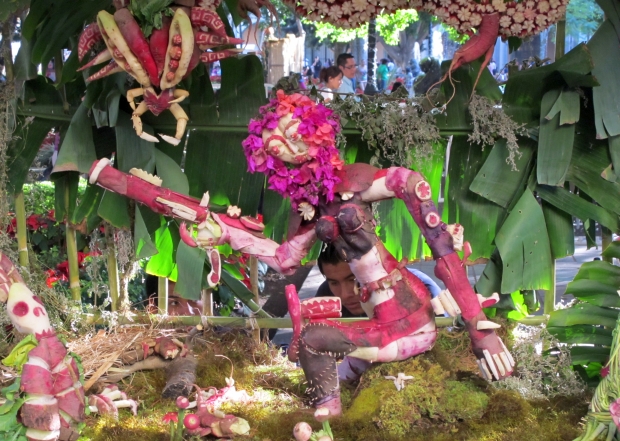
“Oye chica! Tenga aca. Te invitamos!” Someone was calling to me as I walked by a makeshift tent on the side of the street in Oaxaca’s old center. Curious, I joined the speaker, a young Mexican man, as well as a few others, underneath their tent.
They had set up a large folding table which, upon closer examination, I found covered with radishes of all shapes and sizes. “Tomas,” said the man, whom I later learned was named Luciano, as he handed me a razor blade and indicated that I was to choose a radish from the heaping pile. As I carefully selected the perfect radish, the rest of the table contentedly shaved, carved, dismantled and reassembled their own radishes into a variety of different shapes and figures.
If I had come upon this scene a few days before, the request might have seemed a bit odd. However, the previous day on my tour of the sights surrounding Oaxaca, my guide had informed me of my great luck in arriving in Oaxaca just in time for their annual Noche De Los Rábanos (Night of the Radishes) festival. I had never heard of this festival before, but I was one of those kids that made words in my alphabet soup and drew smiles on my pancakes with whipped cream, so naturally I was intrigued by the idea of creating art out of food. I ventured into the Zócalo on December 23 (the date the festival has been celebrated since its inception in 1897) to see exactly what made this festival so famous.
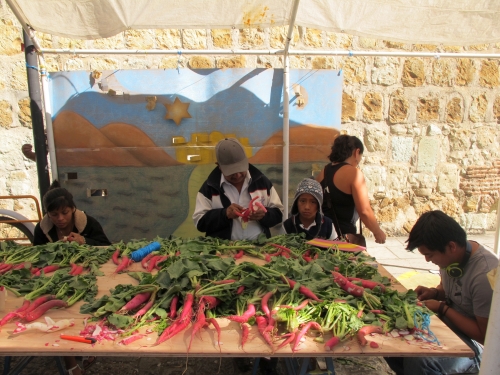
Even in the early afternoon, the main plaza was so full of onlookers that it was difficult to move. The smell of tamales, chile, popcorn and cotton candy lingered in the air and reminded me of the many times I visited the New Mexico State Fair with my family. Vendors called elote and nieve in singsong voices, and children danced to music emanating from the many different portable speaker systems as happy families shared homemade picnics.
While I strategized how to get a better view of the exhibition stalls, an older gentleman motioned for me to take a seat next to his family. “Quieres?” he asked, and offered me a chicken taco.
“No gracias,” I replied.
“Feliz Navidad,” he said with a toothless grin. I then asked him why so many people come to Oaxaca every year specifically for this festival.
“It is important to celebrate our history and our art,” he explained. “It is a time for us to come together and be thankful.” Despite me asking, I never did not get a “historical” explanation about the origins of Noche De Los Rábanos from any person that I asked about the festival; it was obvious that the most important thing to these locals was spending time together and sharing in the appreciation of Mexican creativity. And the joy was tangible.
Noche De Los Rábanos was first celebrated in 1897 in Oaxaca’s “zócalo” (main plaza). Originally, radish farmers, with an overabundance of radishes from the harvest, decided to create art out of the excess crop in order to generate more radish sales.
However, this activity quickly grew in popularity. Since then, annually on the morning of December 23, artisans from all over Oaxaca converge on the zócalo and spend all day constructing intricate scenes made of these large red radishes. These radishes, grown especially for this event, can weigh up to 3 kilograms and grow to lengths up to 50 centimeters. They are left in the ground for months after the normal harvests so that they are able to attain their giant size and strange shapes. The artist whose creation is named best in show gets their picture in the local paper.
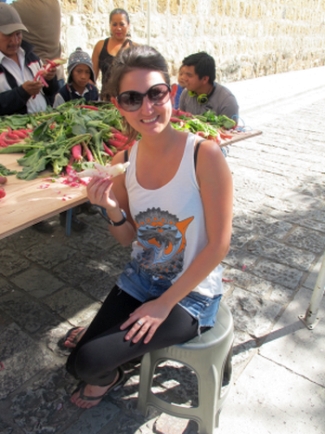
I struggled through the crowd to try and get a better look at the different stands, and as I proceeded I felt hands pushing me forward. My fellow neighbors were moving out of the way to make sure I was able to see. “Veas!” they said, pointing out sights they wanted me to see. Suddenly, I was transformed from a mere visitor in a foreign country into a nominal member of one enormous family.
As I moved from one stand to the next, I found myself casually placing my hand on my neighbor’s shoulder to steady my tip-toed stance. We all smiled in response, and I realized how many times in New York I had stood in close quarters with my fellow New Yorkers, actively trying to avoid physical contact. In Mexico, personal space has another purpose: its breach, rather than an offense, signifies friendship, comradery and acceptance.
I moved along with the wave of people, and each stand was more impressive than the last — an amazing representation of the creativity, beauty and history of Mexico. The artists, I learned, are mostly radish farmers turned professional craftsmen and aficionados. The scenes cover an array of topics from the nativity, to models of saints and famous figures, to fiestas, to the flora and fauna of Mexico. While the main artistic features are made of radishes, these scenes include other materials such as dried flowers and corn husks.
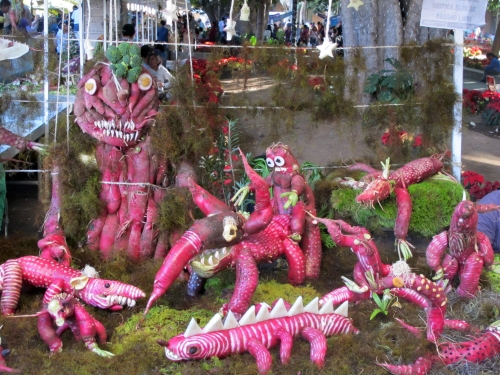
“Ah, un delfin!”, Luciano said to me approvingly, looking over my shoulder as I attached the fins to my radish-turned dolphin. As we spent the next hour admiring each others’ creations, my fellow artists asked me about my experiences in Mexico, how I was enjoying Oaxaca and what it was like to live in New York City.
We conversed like old friends, Luciano poking fun at my dolphin’s lopsided tail, another comparing his hand-like creation to that of a witch. It made no difference that I was a single girl traveling alone, that my Spanish was not perfect, nor that prior to that day I had no idea that Noche De Los Rábanos even existed.
After I visited all of the different Rábanos scenes, I wandered back towards my apartment through Oaxaca’s main thoroughfare. People smiled and exchanged Feliz Navidads, and gasped with excitement when fireworks streaked the sky with radiant blues, pinks and oranges.
As I left the main street behind, I passed by the now deserted tent where we had earlier created our own radish art. Someone has arranged all of our creations into one beautifully chaotic diorama.
Even though our scene had no specific theme (we had created everything from animals to cars to abstract figures), to me it was the most powerful scene of all because it represented the beauty that is created through acceptance and friendship. I smiled, thinking to myself how Noche De Los Rábanos is much more than just an art festival. It is a true expression of the Mexican persona: open, accepting, generous and full of joy.
By Chelsea Perino

About the Author
 Chelsea Perino is an avid traveler and has visited over 60 countries, mostly as a solo female. Chelsea recently graduated with a Master’s Degree in Public and Organizational Relations and is now a freelance Public Relations and Marketing consultant and writer in New York City. She is the Co-Founder of her own online lifestyle magazine DIY-NYC.com.
Chelsea Perino is an avid traveler and has visited over 60 countries, mostly as a solo female. Chelsea recently graduated with a Master’s Degree in Public and Organizational Relations and is now a freelance Public Relations and Marketing consultant and writer in New York City. She is the Co-Founder of her own online lifestyle magazine DIY-NYC.com.
The post How A Radish Festival In Oaxaca Made Me Feel Like A Mexican appeared first on The Expeditioner Travel Site.
]]>The post An Insider’s Guide To Belgium’s Biggest Party: The Ghent Festival appeared first on The Expeditioner Travel Site.
]]>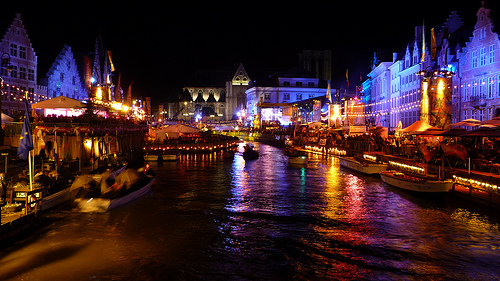
Belgium probably does not spring to the front of one’s mind when considering examples of hip happenings and exciting cultural phenomenon. It is more a place one would associate with a platter of well-prepared mussels, the setting for In Bruges perhaps, or somewhere your grandmother may elect for a weekend away with Aunty Joyce.
But, if we hold those judgmental horses of ours for just a moment, we would see that Belgium has in fact been wildly underestimated.
Bring forth the Gentse Feesten!
Forget saving your pennies for the likes of Oktoberfest. Between July 14th – 23rd, the annual Gentse Feesten or “Ghent Festival” is set to enjoy it’s 169th edition. A free celebration of music, excellent beer and light-hearted debauchery and located in one of the regions most beautiful cities, 30 miles northwest of Brussels. It is a veritable master class in how people with trendy hair and bicycles know how to party.
Having eagerly juiced the minds of some of GF’s most weathered disciples, The Expeditioner is pleased to present an “Insider’s Guide” to the whole Flem-tastic debacle.
To get the night started . . .
. . . Graslei is the place. Right on the river, this is area of the festival has become synonymous with a sexy southern vibe. Dance, drink a mojito and get acquainted with Ghent’s nefarious student population, shaking your booty to latino beats and african soul. Closing at around 1 p.m., you’ll need to get here in good time to take advantage of pop-up bars hosted by popular clubs and bars, such as Hasta Manana and Pole Pole.
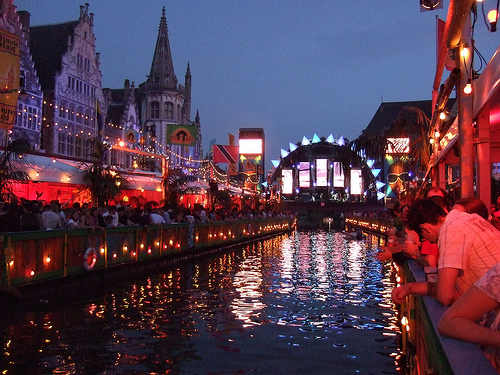
You haven’t fully experienced the GF until . . .
. . . you’ve eaten Uuflakke. Uuflakke is a Ghentish delicacy and comprises a slice of minced pig head coated in herbs and gelatin, smeared with mustard on a piece of bread. Yes, it may sound horrendous, but it is a signature dish of the festival. So, make like a true Ghentonite, head to the Vlasmarkt and embrace your inner pork-brain-loving Belgian.
The two words you have to be able to say are . . .
. . . “De max!” which translated basically means “Awesome!” Be sure to exclaim this often and at seemingly significant points in order to express excitedness, thus becoming one with the natives.
To save money like a local you should . . .
. . . buy your alcohol from a Nachtwinkel (night shop) rather than from one of the many temporary bars that spring up around the city. Much of the entertainment is outside, so you won’t be missing out by opting to bring your own booze rather than being inside a pub. (Note: While this is a sure fire way of conserving funds, be aware that this is also somewhat of a moral choice; the GF is free and partly relies on funds coming from bar alcohol sales to keep it that way.)
If you are feeling overwhelmed by all the noise and the crowds . . .
. . . head to Baudelo Park. Here you will find a rather more relaxed approach to the whole affair. Lie on the grass and contemplate the weird and wonderful plethera of folk who frequent this relative oasis of tranquility. Be sure to venture into the Spiegal Tent or “The tent of mirrors,” a birthplace of yet undiscovered singer songwriters.
To stay healthy, you should . . .
. . . . schedule in at least one evening off during the festival. While the slogan for the GF is “Nie neute, nie pleuje” (“Don’t whine, don’t give up”), this is a marathon in partying and needs to be respected as such. In order to cross the finishing line in style, and with all your limbs and at least a few of your brain cells still functioning, you have to give yourself a chance to recuperate.
Keep your fingers crossed that . . .
. . . “The voice of Europe,” Eddy Wally, makes a return appearance. For many, this showman, crooner and regular on the U.K. show Eurotrash epitomizes the spirit of the festival, and has been a staple of the GF for many years. Unfortunately, due to ill health, his 2012 billing may be in jeopardy.
To get the most out of the experience . . .
. . . remember that this isn’t a festival solely preoccupied with getting sozzled. The GF also represents almost an entire fortnight bursting with activities for all ages and dispositions, from innovative street theater to jazz and circus performances, to hours and hours of live music. Check out Gentsefeesten.be for more information, including the full event program.
*
A special thanks to Pieterjan Colpaert; his mind offerings were fundamental in putting this together. At any point during the festival, you will find him at one of the points of the “Magic Triangle”: Pole Pole, Baudelo Park or the Vlasmarkt.
[Ghent Festival by Steve & Jemma Copley/Flickr, Gentse Feesten by David Ooms/Flickr]

About the Author
 A restless Brit with big dreams and limited cash flow, Hannah is a freelance journalist and student. She is currently being sponsored by the European Union to take a Masters in Journalism and International Politics at the University of Amsterdam/University of Santiago, Chile, and the Danish School of Journalism. You can keep track of her wanderings with TheTangerineRidiculousness.com or follow her on Twitter @Hannah__Bowman.
A restless Brit with big dreams and limited cash flow, Hannah is a freelance journalist and student. She is currently being sponsored by the European Union to take a Masters in Journalism and International Politics at the University of Amsterdam/University of Santiago, Chile, and the Danish School of Journalism. You can keep track of her wanderings with TheTangerineRidiculousness.com or follow her on Twitter @Hannah__Bowman.
The post An Insider’s Guide To Belgium’s Biggest Party: The Ghent Festival appeared first on The Expeditioner Travel Site.
]]>